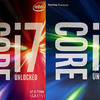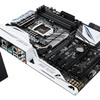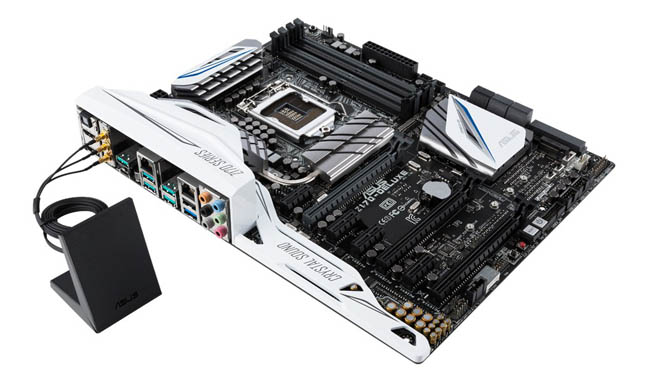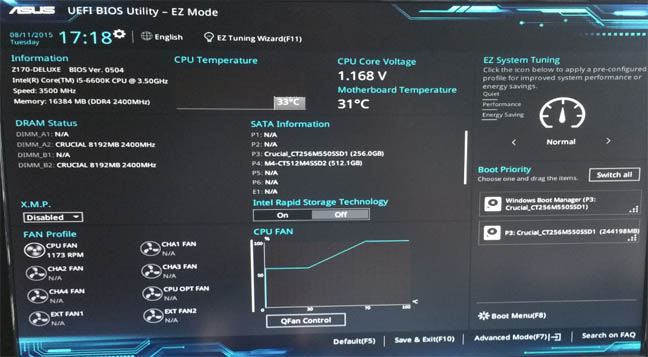This article is more than 1 year old
All aboard the Skylake: How Intel stopped worrying and learned to love overclocking
6th gen CPU and swanky Asus mobo on test
Calming the BIOS fear
Asus provides the board with a decent number of chassis fan headers: four 4-pin as well as a dedicated 4-pin header for a water-cooling pump, which has a page all to itself in the BIOS.
Talking about the BIOS, the way Asus has gone about designing its UEFI BIOSes has been impressive from day one, with each incarnation leaving the competition further behind each time. That trend doesn’t look like stopping any time soon, as the Z-170 Deluxe’s BIOS is, in a word, superb.
The BIOS now includes the ability to flash it via the internet (EZ Flash 3) without entering the OS. There’s SSD secure erase (something handed down from the ROG product line), as well as monitoring S.M.A.R.T information for hard drives and information about the graphics card.
View from the bench
To test the ASUS Z-170 Deluxe, I used an Intel Core i5-6600K with a 16GB kit (2 x 8GB) of Crucial Ballistix Elite DDR4-2666, a Crucial M550 (256MB) and a Zotac GTX760 AMP! Edition. Although the socket has changed, thankfully, the cooler mounting pins are still in the same position as for the 1150/1155/1156, so I was able to use my usual air cooler – a Noctua NH-U9S with dual cooling fans.


Overclocking performance test results with Cinebench and x264 HD
First off, I ran through my suite of benchmarks at the standard clock speeds. PCMark 8 notched up a Home score of 4204 (conventional) climbing to 4499 (OpenCL accelerated). With 3DMark, the dedicated Nvidia GTX760 delivered 906 (Fire Strike Extreme), 2881 (Fire Strike Ultra) and 17304 (Fire Strike). With all in-game details set to as high as possible, the average frame rates were 43.6fps (Total War: Rome), 81.84fps (Grid Autosport) and 40.07fps (Metro 2033).
Other tests appear in the graphs below, alongside a touch of overclocking. Initially, I used the Asus EZ Tuning wizard, which allows you to overclock the CPU and tune any RAID array without getting your hands dirty by delving further into the BIOS.
The opening screen of the wizard shows the current system configuration, the next gives you two choices; Daily Computing or Gaming/Media Editing, the third screen asks what type of cooling you have – box, tower or water cooling – and the final screen gives you what the overclock will be and a button to reboot the system.


Overclocking performance test results for CPU temperature and power consumption
The resulting OC for my set-up was a very conservative base clock of 3.5GHz, a mere 100MHz over the standard speed. Time to go into the BIOS proper: I tried various settings and got the CPU to boot at 4.7GHz, but it wasn’t stable and finally settled on 4.5GHz at 1.35V, which ran the benchmarks without any further problems.
One problem I did come across – that neither I nor Asus could find an answer to – was why I couldn’t get the integrated graphics on the CPU to work. Investigations are ongoing, but it's unfair to speculate on a dodgy mobo or CPU. Also, this kit is too new for there to be forums reporting similar issues. We'll add a bootnote if we get to the bottom of this.
The Reg Verdict
If you want a comprehensive range of options, the Asus Z-170 Deluxe is a board that is hard to fault. Yes, it’s expensive, but you do get some motherboard for your hard-earned cash. The BIOS is a work of art on its own – an example to many others how to write a UEFI BIOS. When it comes to storage support, it has plenty of futureproofing both built in and supplied as extras in the box. What's not to like?
As for Skylake's changes, if you have just splashed out for a Z97 platform, any anger and frustration felt following this new release is understandable, as it brings with it a new socket/new memory type. But if you are still thinking about upgrading, then it might be time to aim your wallet towards Intel's latest platform. ®

All aboard the Skylake: How Intel stopped worrying and learned to love overclocking



